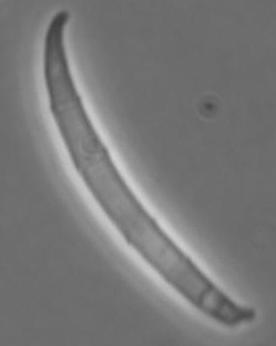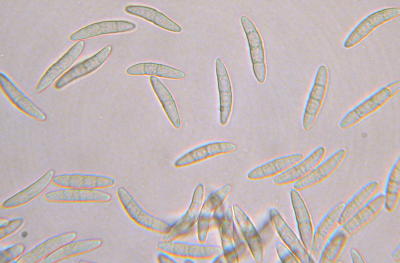This month's fungus is Gibberella zeae. If you're a plant pathologist, you might know this fungus better by its anamorph (asexual) name, Fusarium graminearum. This ascomycete fungus is the causal agent of head blight of wheat (shown to the left-- isn't it beautiful?) and, as such, has caused an estimated several billion dollars worth of damage in the US alone over the past decade. Plant pathologist study plant diseases in an effort to be able to control them. Every crop plant has a cadre of diseases that affect the way it can be used by people or at least affect its yield. You can read about some of these plant pathogens in an entertaining way here at "Fungal diseases that must be overcome to have a traditional Thanksgiving dinner."
In head blight of wheat, newly emerging wheat heads (the fruits, which contain the seeds, the part that we eat) are infected by forcibly discharged, airborne ascospores released by G. zeae that has overwintered on crop debris. The spore germinates on a wheat kernel, penetrates, and grows down through the stalk. Once a certain fungal mass is reached, fruiting structures penetrate though the wheat's stomates (the breathing apparatus on its leaves). These fruiting structures may be either asexual (sporodochia; cushions of conidiophores and conidia), in which case we refer to the Fusarium state, or sexual (perithecia, containing asci and ascospores). The factors that lead Gibberella zeae to favor sexual or asexual structures are unclear; unlike some fungi, either structure can be produced throughout the season, and environmental cues can cause the fungus to switch back and forth. Finally, the wheat dries up and dies, the fungus goes dormant to overwinter in the debris, and the cycle can begin again in the spring.
 Fusarium conidia are very distinctive; "banana-shaped" is one of the terms commonly used to describe them. Fusarium graminearum/Gibberella zeae produces only one kind of conidia - macroconidia - and these possess three septa at maturity as well as the classic Fusarium "foot cell" (see the little knob that looks like the heel of a boot? - That's the foot cell; it originates as the point by which the conidium is attached to the conidiophore). Several Fusarium species produce small, single-celled microconidia as well as the macroconidia, and this can be used as an identifying feature. As in many Fusarium species, the conidia of F. graminearum are pink.
Fusarium conidia are very distinctive; "banana-shaped" is one of the terms commonly used to describe them. Fusarium graminearum/Gibberella zeae produces only one kind of conidia - macroconidia - and these possess three septa at maturity as well as the classic Fusarium "foot cell" (see the little knob that looks like the heel of a boot? - That's the foot cell; it originates as the point by which the conidium is attached to the conidiophore). Several Fusarium species produce small, single-celled microconidia as well as the macroconidia, and this can be used as an identifying feature. As in many Fusarium species, the conidia of F. graminearum are pink.
 The sexual state, Gibberella zeae, is characterized by purple to black perithecia - a distinguishing feature of the genus Gibberella. The ascospores, like the conidia, are septate, usually with three septa. In a mixed culture, where both ascospores and conidia are present, you can tell them apart because the ascospores are slightly shorter and fatter than the conidia, and the ascospores lack the foot cells. The spores are shot out of the ascus at 870,000 times the force of gravity; the most powerful acceleration yet known from a biological system.
The sexual state, Gibberella zeae, is characterized by purple to black perithecia - a distinguishing feature of the genus Gibberella. The ascospores, like the conidia, are septate, usually with three septa. In a mixed culture, where both ascospores and conidia are present, you can tell them apart because the ascospores are slightly shorter and fatter than the conidia, and the ascospores lack the foot cells. The spores are shot out of the ascus at 870,000 times the force of gravity; the most powerful acceleration yet known from a biological system.
Besides drastically decreasing the yield of wheat, G. zeae harms the crop in another way-- it produces two major mycotoxins, zearalenone and deoxynivalenol. Zearalenone is a so-called phytoestrogen; it mimics mammalian estrogen, with potentially disastrous consequences should it get into the food chain. In farm animals, zearalenone has been known to cause abortions in pregnant females, and feminization of males. The other major toxin, deoxynivalenol, is also known as vomitoxin, which should provide some clue as to its effects. It is considered an antifeedant; pigs that eat corn contaminated with vomitoxin become sick and then, like someone who's suffered a recent food poisoning, refuse to eat any further.
Interestingly, this mycotoxin-producing fungus is closely related to the Fusarium species used to make Quorn, a vegetarian meat substitute. Initially the Quorn fungus was in fact believed to be a nontoxic strain of Fusarium graminearum; molecular systematics now have given it its own species, F. venenatum. Incidentally, Heather eats Quorn several times a month and finds it delicious. Tom finds it to be good, but too salty. Someday the Quorn fungus will be a fungus of the month.

Gibberella zeae is a very good lab fungus. Because it is a major plant pathogen and a mycotoxin producer, it receives a lot of study. Additionally, it has other useful features that characterize model organisms. Gibberella zeae is homothallic - it can undergo sexual development and reproduction without needing to encounter an opposite mating type. It can be induced very readily to undergo sexual development in the lab, by the somewhat improbable expedient of growing it on carrot agar, scraping the surface mycelia off, and rubbing it with a weak detergent (a 2.5% solution of Tween 20). It develops very predictably, with wide, dikaryotic hyphae forming 24 hours after sexual development has been induced with Tween. At 48 hours, perithecial initials are present. At 96 hours, immature perithecia are present, with the purple pigmentation beginning to be visible and with paraphyses inside the perithecium. And at 144 hours, the perithecia are mature, the paraphyses have collapsed, and multiseptate ascospores are present.

What does this matter? Well, since ascospores are the principal source of new infections in the field, understanding ascospore development is important in understanding - and maybe preventing - disease spread. Additionally, G. zeae has some nifty tools to help us do more than just watch ascospores develop during a time course.
G. zeae is one of several fungi for which complete genome sequence has become available over the past few years (see http://www.broad.mit.edu/annotation/fungi/fusarium/ or http://mips.gsf.de/genre/proj/fusarium). The availability of a complete genome sequence enables us to target particular genes that may be involved in interesting processes (ascospore discharge, sexual development, toxin production...), knock the genes out and see what the effect is on the fungus. Conversely, we can use microarrays (DNA sequences embedded on a microslide) to look at fungi that are known to be deficient in toxin production or spore discharge to determine which genes may be responsible. The availability of the genome sequence has already enabled researchers to identify the two genes responsible for zearalenone synthesis and knock them out, producing a zearalenone-free fungus in the lab. A long way down the road, such information may enable us to develop very specific fungicides to attack G. zeae in field crops while leaving innocuous fungi alone.
 We hope you have enjoyed learning something about Gibberella zeae or Fusarium graminearum, an all-around nasty fungus if you're a plant trying to produce grains. This month's co-author is Heather Hallen. Heather is now working in a Gibberella lab at Michigan State University, so she's becoming quite expert on the subject. You may also know her as a co-author of this page on Gastrocybe lateritia, the bean sprout mushroom. She's smiling here on the left.
We hope you have enjoyed learning something about Gibberella zeae or Fusarium graminearum, an all-around nasty fungus if you're a plant trying to produce grains. This month's co-author is Heather Hallen. Heather is now working in a Gibberella lab at Michigan State University, so she's becoming quite expert on the subject. You may also know her as a co-author of this page on Gastrocybe lateritia, the bean sprout mushroom. She's smiling here on the left.
If you have anything to add, or if you have corrections, comments, or recommendations for future FotM's (or maybe you'd like to be co-author of a FotM?), please write to me at volk.thom@uwlax.edu
This page and other pages are © Copyright 2005 by Thomas J. Volk, University of Wisconsin-La Crosse. Learn more about fungi! Go to Tom Volk's Fungi Home Page --TomVolkFungi.net
Return to Tom Volk's Fungus of the month pages listing


